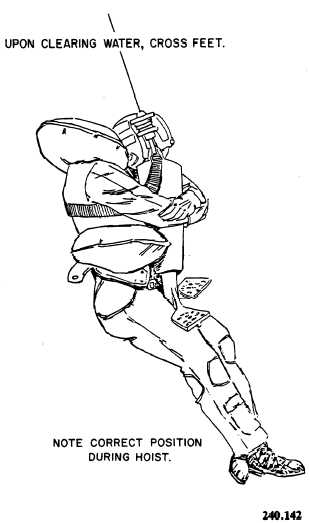The rescue seat is an optional rescue device and is not normally carried by all rescue-capable helicopters. However, it is a suitable substitute for the forest penetrator for some applications.
WARNING
Failure to assume proper position on rescue seat could result in serious injury if hard contact is made with aircraft during hoist operation.
ATTACHMENT PROCEDURE. - The following is an attachment sequence for the rescue seat:
1. Swim to the rescue seat. Draw it to you and position one of the three flukes of the seat between your legs.
2. Disconnect the snap hook of the safety strap from the V-ring, pull the safety strap free, pass it under your arm, around your back, and under the other arm; then reconnect the V-ring to the snap hook and tighten the strap.
3. Give a thumbs-up hand signal to the hoist operator, put your head down to the left, and wrap your arms around the rescue seat. Upon clearing the water, cross your legs as shown in figure 5-34.
RESCUE SEAT OPERATIONAL DIFFICULTIES. - Ensure that the safety strap is on and that you hold tightly to the flotation chamber. Do not lean back; it will cause the rescue seat to swing and tilt away from the rescue hook.
Rescue Seat (Swimmer-Assisted Rescue) During swimmer-assisted rescues using the rescue seat, the swimmer uses the following procedures to attach the survivor to the hoist cable:
1. After the rescue seat is in the water, faces the flotation chamber and assists the survivor in sitting on the seat.
2. Disconnects the safety strap; passes it under one arm, around the back, under the other arm, and reconnects the V-ring to the rescue hook.
3. Tightens the strap.
4. Has the survivor wrap his arms around the flotation chamber.
5. Signals the aircraft "ready for hoist."
WARNING
The survivor must not attempt to get off the rescue seat until directed by the crewman.
6. After the survivor is hoisted to the helicopter, the crewman assists the survivor into the helicopter.
The rescue net is a simple and safe rescue device that can be used to hoist two survivors into a helicopter. It is designed for multiple rescue scenarios or for rescuing survivors who are unfamiliar with other rescue devices, such as the rescue strop or rescue seat. A lifting ring for hoisting is located at the top or upper portion of

Figure 5-34. - Rescue seat maritime rescue procedure.
Continue Reading